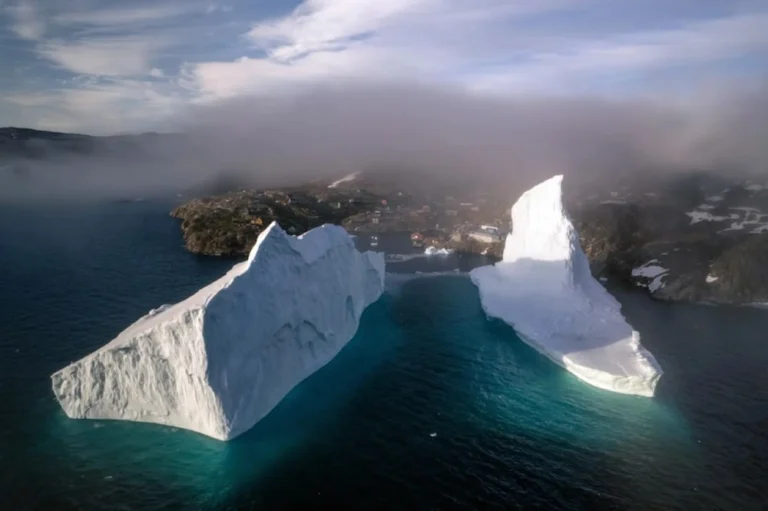Critical 2 Giant Icebergs Climate Threat: Greenland and South Georgia on Alert

Icebergs dangerously close to the coast 19/7/2025 Photo: SWNS
July 19, 2025 Hour: 8:13 am
Two giant icebergs — one near Greenland and A23a near South Georgia — pose growing climate threats. Explore the risks to ecosystems, coastal communities, and global environmental balance.
Related:
World Records Third-Warmest June, Says Copernicus Climate Change Service
Glacier Collapse Buries Swiss Village That Voted Against Climate Change Policies
Geopolitical and Environmental Context of the Giant Icebergs Climate Threat
The giant icebergs climate threat has taken center stage as two massive ice formations — one near Greenland and the other approaching South Georgia Island — raise alarms among scientists, local authorities, and environmental organizations. These events highlight the growing interplay between natural glacial cycles and the accelerating effects of global warming.
In Greenland, a towering iceberg has forced the temporary closure of critical infrastructure in the coastal village of Innaarsuit, while the massive A23a iceberg, now approaching South Georgia, threatens fragile marine ecosystems. These developments underscore how climate change is altering traditional patterns of iceberg movement, increasing the risk to both human settlements and biodiversity.
🔗 National Geographic – Iceberg Movement Reports
Greenland Iceberg Puts Coastal Town on High Alert
A colossal iceberg, comparable in size to a skyscraper, has triggered emergency measures in Innaarsuit, a small coastal community in northern Greenland. The local fish processing plant operated by Royal Greenland and the town’s main market were temporarily shut down as the iceberg drifted dangerously close to the harbor.
Authorities issued safety advisories, particularly for elderly residents and those with limited mobility. The event echoes a similar incident in 2018, when a nearby iceberg caused tsunami-like waves that forced part of the population to evacuate.
🔗 Royal Greenland – Official Statement
A23a Iceberg: A Looming Environmental Crisis in the South Atlantic
Meanwhile, the A23a iceberg — spanning an estimated 3,500 square kilometers — is advancing toward the South Georgia Islands, a British Overseas Territory and one of the most biodiverse marine regions on the planet. Currently around 280 kilometers from the archipelago, the iceberg poses a serious risk if it becomes lodged on the continental shelf.
Should this happen, penguins, seals, and seabirds could be cut off from vital feeding grounds, disrupting the delicate ecological balance of the area. Scientists from the British Antarctic Survey warn that the iceberg’s melt could release long-trapped nutrients, chemicals, and microorganisms, potentially altering deep-sea carbon cycles.
🔗 British Antarctic Survey – A23a Impact Report
Climate Change and Natural Cycles: A Complex Interaction
While scientists stress that iceberg calving and drift are part of natural polar cycles, the frequency and scale of these events are being exacerbated by rising global temperatures. The A23a iceberg, originally detached from Antarctica’s Filchner Ice Shelf in 1986, remained trapped in an oceanic gyre for decades before breaking free in late 2024.
Its current trajectory is being closely monitored, as it could mark not only the end of a long drift, but the beginning of a new phase of climate-related environmental disruptions. As icebergs reach lower latitudes more frequently, the need for improved early warning systems and ecological monitoring becomes increasingly urgent.
Threat to South Georgia’s Unique Biodiversity
The giant icebergs climate threat to South Georgia is particularly concerning due to the region’s ecological significance. Home to millions of penguins, seals, and migratory seabirds, the islands rely on predictable marine conditions for survival.
If A23a becomes grounded, it could block access routes for marine life, leading to localized food shortages and population displacement among vulnerable species. This scenario is being closely studied by conservationists, who fear a cascading effect on the broader Southern Ocean ecosystem.
“The iceberg’s melt may bring nutrients, but it could also disrupt feeding patterns and breeding cycles,” said a marine biologist at the British Antarctic Survey.
Greenland’s Iceberg: A Repeat of Climate Vulnerability
In Greenland, the presence of a massive iceberg near Innaarsuit has revived memories of the 2018 event, when a similar formation triggered a partial evacuation. Local authorities say controlled demolition or towing of such ice masses is not feasible due to the risks and costs involved.
Climate experts note that Greenland is losing ice at an increasing rate, with approximately 40,000 medium to large icebergs breaking off annually from Arctic and Greenlandic glaciers. While most melt before reaching lower latitudes, those that do pose serious risks to coastal settlements and shipping lanes.
Conclusion: Adapting to a World of Moving Ice and Uncertain Coasts
The giant icebergs climate threat now unfolding in Greenland and the South Atlantic is a stark reminder of how climate change is reshaping our planet’s natural rhythms. What were once predictable glacial cycles are now marked by unpredictability, posing new challenges for coastal communities and marine conservation.
As icebergs like A23a drift farther and stay afloat longer, the world must strengthen scientific monitoring, early warning systems, and adaptive policies to protect both human and natural populations from the growing risks of a warming world.
Author: JMVR
Source: Al Mayadeen

